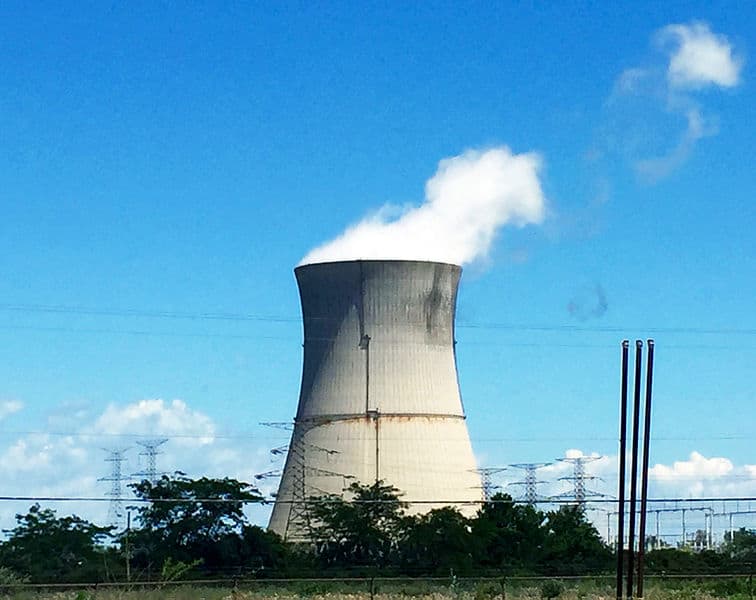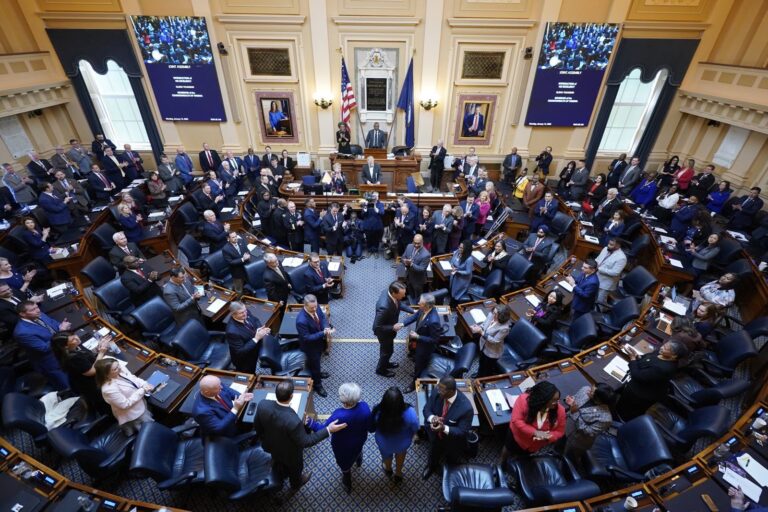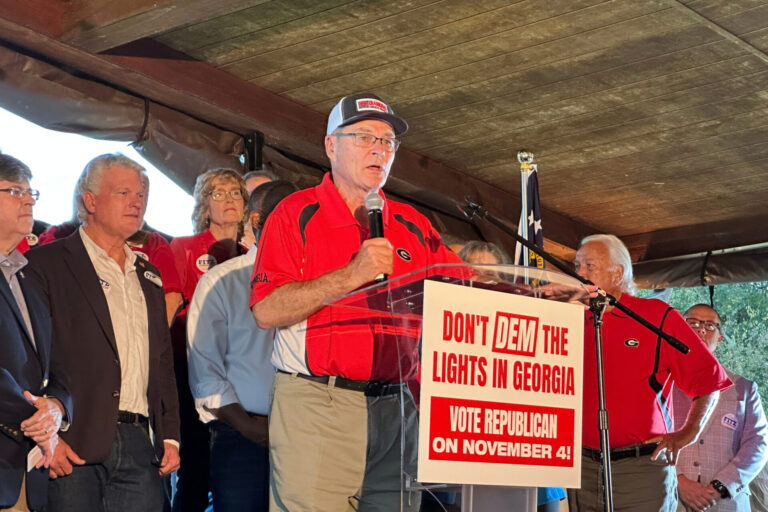Anti-wind activist who backed nuclear bailout bill tied to FirstEnergy

An anti-wind power activist who testified in support of a bill to bail out FirstEnergy Solutions’ nuclear power plants in Ohio did not disclose that he’s worked for the same bankrupt utility at one of the plants.
Dennis W. Schreiner testified in favor of HB 6 last Thursday at a hearing held by the Ohio House Energy and Natural Resources Committee.
In his testimony, Schreiner supported the bill for providing financial support to Ohio’s nuclear power plants, and railed against the current process for the “siting of industrial wind and solar power plants in rural areas” of the state. He accused wind and solar developers of operating “under a cloak of secrecy” to secure leases from landowners.
“Would your children want to return home to a place where the horizon has been obliterated and the night sky can no longer be seen – replaced by dozens of flashing lights?” Schreiner asked lawmakers.
Schreiner did not disclose in his written and oral testimony that he’s worked as a senior consulting engineer for FirstEnergy, as confirmed by his LinkedIn profile, which lists his employment by the utility from “1988 to present.” His name appears among the claims listed in FirstEnergy Solutions’ bankruptcy case.
A 2018 Statehouse News article described Schreiner as “a supervisor of nuclear engineering programs at Davis-Besse,” a nuclear plant that FirstEnergy Solutions (FES) plans to close in 2020 unless it receives financial assistance from Ohio or the federal government.
While Schreiner complained at the hearing about having to look at wind turbines, the cooling tower at Davis-Besse is 493 feet tall, and dominates the view along the portion of the Lake Erie shoreline where it’s located.
The latest version of the bailout bill that Schreiner supported would also roll back Ohio’s renewable energy and energy efficiency standards and make it harder to build new wind farms in the Buckeye State.
Under the bill, new wind farm projects could face another hurdle on their way to approval. Wind power projects could face up or down votes in local referendums, a step not currently required for new fossil fuel projects in the state.
The bill would also extend existing bailouts for two coal-fired power plants operated by the Ohio Valley Electric Corporation, or OVEC, which is collectively owned by American Electric Power, Dayton Power & Light, Duke Energy, and other utilities.
The OVEC provisions of the bill could result in AEP, DP&L, and Duke Energy customers paying millions more to subsidize the Clifty Creek and Kyger Creek coal plants through 2030, according to the Ohio Environmental Council Action Fund.
When FES filed for bankruptcy last year, its then-president and chairman Donald Schneider listed “growth of renewable energy” and “legislation requiring the implementation of energy efficiency measures” among the factors “rendering coal and nuclear plants less competitive,” and resulting in a substantial decline in the utility’s revenue from coal and nuclear generation.
Schreiner’s testimony came after the Energy and Policy Institute discovered evidence that an outside lobbying firm and front group paid by FES played a role in the earlier testimony delivered by seven proponents of the same bill.
Schreiner is involved in a “grassroots” anti-wind power group, and has ties to a lawyer for the coal industry
A Facebook post by the Seneca Anti-Wind Union identified Schreiner and two other anti-wind activists who testified at Thursday’s hearing as members of the group.
Schreiner told lawmakers that “I help coordinate a bunch of folks who have concerns” about wind power projects.
Like Schreiner, the Seneca Anti-Wind Union is supporting the addition of anti-wind power language to HB 6, a move that came as no surprise to the local news site TiffinOhio.net:
The Seneca Anti-Wind Union’s support for a bill that is being called a “bailout for the nuclear and coal industry” shouldn’t be surprising, given the fact that SAWU has been accused of having ties to lawyers for “Big Coal” as well as “stirring angst & fear by spreading propaganda linked to the coal industry.”
Earlier reporting by the Energy and Policy Institute found that some members of the anti-wind group are represented in fights against new wind farms before the Ohio Power Siting Board (OPSB) by John F. Stock, an attorney at the law firm Benesch, Friedlander, Coplan & Aronoff LLP.
Earlier this month, Schreiner’s name appeared on a petition to intervene in the OPSB case for the Emerson Creek Wind Farm that was filed by Stock on behalf of residents of Erie, Huron, and Seneca Counties.
In a separate case before the Public Utilities Commission of Ohio, Stock has also been representing the Ohio Coal Association in its fight against AEP’s plans to invest in new wind and solar projects in Ohio .
The Plain Dealer revealed last summer that coal producer Murray Energy Corp. quietly bankrolled Stock and an expert witness as they represented two Bratenahl residents who opposed the Icebreaker offshore wind power pilot project on Lake Erie in another OPSB case. The Bratenahl residents said they were initially unaware of Murray Energy’s funding of their attorney and expert witness.
Stock previously represented a shadowy coal industry-backed group called the Campaign for American Affordable and Reliable Energy that popped up in a number of wind power cases before the OPSB, as first reported by the Energy New Network.
Another anti-wind operative recommended that HB 6 include money for coal, and exclude money for wind power in emails with lawmakers
Julia F. Johnson, an anti-wind activist and close ally of Ohio House Majority Floor Leader Bill Seitz, also testified at last Thursday’s hearing.
Emails regarding HB 6 obtained from Rep. Seitz via an Open Records Law request included a message from Johnson to two anti-wind operatives who work with special interest groups funded by the fossil fuel industry.
One was Kevon Martis, a Michigan-based opponent of wind power and senior fellow for the Energy & Environment Legal Institute, a Virginia-based climate skeptic group that has received funding from the coal industry.
The other was Tom Stacy, an Ohio-based anti-wind activist turned paid consultant who has worked with other groups backed by the coal industry, including the American Coal Council and Washington, D.C.-based Institute for Energy Research (IER).
The Intercept revealed earlier this month that IER was listed as a creditor in the bankruptcy case of Cloud Peak Energy, a major producer of coal. IER has long worked to promote the often misleading views of anti-wind activists, and most recently published a defense of President Trump’s false claim that noise from wind turbines can cause cancer.
Stacy is also a member of the board of directors for the National Wind Watch, a top anti-wind group that claims to have no ties to the fossil fuel industry or any related political group.
In an email to Seitz about HB 6 from April, Stacy wrote that he was still “gainfully employed by groups in DC at the moment and very busy.”
An email thread Seitz forwarded to several key lawmakers on April 26th included messages from Johnson, Stacy and Dan Kish, a ”Distinguished Senior Fellow” at IER who previously served as an energy and environmental policy advisor for former U.S. House Speaker Paul Ryan.
In the emails forwarded by Seitz, Stacy said he hoped that wind power “will not see any dollars” from HB 6. He wanted lawmakers to “simply change the incentive to reward the retention of firm capacity resources and a balance of fuels among them including coal.”
Seitz forwarded the emails from Kish, Stacy, and Johnson to Nino Vitale, the chair of the Energy and Natural Resources Committee, and other state legislators, including HB 6 sponsors Reps. Jamie Callender and Shane Wilkin.
The version of the bill that later passed out of Vitale’s committee excluded support for wind and solar power, and included the extension of bailouts for the OVEC coal plants.
It’s not clear how much influence Seitz’s email chain had on the evolution of the bill compared to lobbying on the bill by the coal and utility industries.
The utilities that own the OVEC coal plants have heavily lobbied Ohio lawmakers for bailouts.
The Ohio Coal Association recently disclosed lobbying on HB 6. It also reported lobbying on another bill that would ease Ohio’s restrictive setbacks on new wind turbines. That bill that is opposed by anti-wind activists in the state.
The chair of the committee that approved the bailout bill is an ally of anti-wind forces in Ohio
Like Seitz, Vitale is a close ally of anti-wind forces in Ohio, and anti-wind provisions were added to the bill while it was before his committee.
In 2014, Tom Stacy wrote that Vitale’s election was a win for anti-wind activists and a loss for the wind power industry, in a post that appeared on IER’s blog MasterResource.org.
In a 2016 press release titled “Guns, Babies And Energy – Hot Bills At The Ohio Statehouse,” Vitale also celebrated the passage of an earlier bill to roll back Ohio’s “mandates” for renewable energy. That bill was vetoed by then Republican Governor John Kasich.
Top photo is of a cooling tower at FirstEnergy’s Davis-Besse nuclear power plant by Joseph Varnum obtained on Wikipedia Commons. Creative Commons Attribution-Share Alike 3.0 Unported License



